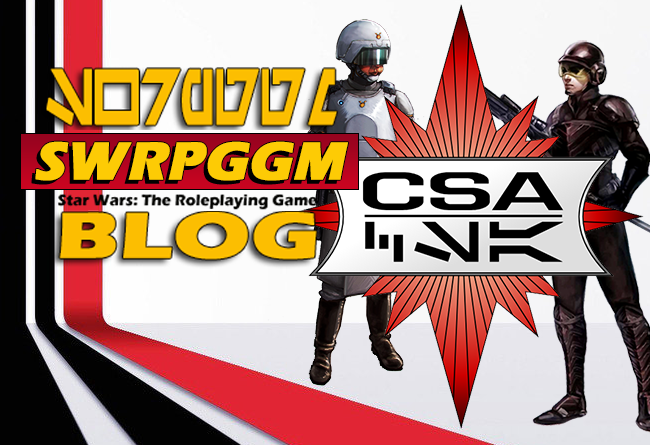The Corporate Sector Authority, also known as the CSA or the Authority, is a corporation-controlled government that administers the Corporate Sector, an area of space located in the northeastern part of the galaxy’s Outer Rim Territories. The CSA is responsible for all sector economic, political, and judicial systems and comprises member corporations across the Galaxy.
Early foundations
Before the Imperial Era, the Corporate Sector comprised a series of loosely aligned autonomous star systems. Independent from the Galactic Republic, the Corporate Sector became home to numerous corporations, tax evaders, arms merchants, and pirates. Most of the sector supported the Confederacy of Independent Systems during the Clone Wars. These star systems were considered to be slowly merging into a unified entity, one of the main reasons the Galactic Empire decided to send a message to the systems defying it by occupying the Salient system on the edge of the sector. Despite this, these systems eventually merged to create the Corporate Sector Authority.
Despite the Corporate Sector’s support for the CIS during the war, Galactic Emperor Sheev Palpatine decided against bringing its territory into his Empire. Instead, the CorpSec spread into tens of thousands of systems, placing them under the CSA’s control. The CSA and Empire did create a cooperative relationship with each other, with the authority selling services and goods to the Imperials. At the same time, the Empire helped with the Corporate Sector’s security when needed. When a group of pirates were active in the sector and launching raids, Admiral Wullf Yularen was dispatched to deal with them in a campaign.
Age of the Empire
The criminal Big Bunji once worked with the smugglers Han Solo and Chewbacca on a scam that involved running counterfeit Authority cash vouchers to the poor people on the far side of the Cron Drift. Like it did with the Empire, the CSA sold goods and services to the Rebel Alliance.
New Republic Era
The New Republic Era saw the expansion of the Corporate Sector Authority Security Police and a covert alliance between the CSA and the forming First Order in the Unknown Regions. By 21 ABY, the CSA controlled an army of Espos with more armor and equipment than their security police predecessors. At the same time, the CSA secretly funded the Imperial remnant. High Colonel Enric Pryde, an officer of the remnant, worked with the CSA as a supervisor and was given authority over its forces. Viceprex Coromun, an official of the CSA, served as Pryde’s second-in-command. To maintain the secrecy of the remnant’s connection to the CSA, Pryde was assigned the code name Steadfast.
During a CSA mission on Basta Core, Steadfast was sought out by the Jedi hunter Ochi of Bestoon. An operative of the Sith Eternal cult on Exegol, Ochi requested Steadfast’s assistance with the search for Dathan, Miramir, and their daughter Rey. Steadfast reassigned a company of CSA troopers to Ochi’s command, overruling Coromun’s objections. Despite the CSA’s support, Ochi initially failed to capture Rey and her family and returned to Steadfast to request more detachments of CSA troops. Instead, Steadfast denied the hunter’s request, having terminated their arrangement and further warned Ochi to avoid the Corporate Sector.
During the Cold War, Resistance leader General Leia Organa received intelligence that the Corporate Sector Authority was giving monetary support to the First Order, which was channeling large sums of money to Senator Erudo Ro-Kiintor’s accounts through shells and third-party corporations via the CSA.
A former Councillor, Sturg Ganna, was untouchable by the Canto Bight Police Department and the Corporate Sector Authority Security Police.

CSA Organization
Security & Military
The Corporate Sector Authority was an oppressive power that controlled the Corporate Sector. The CSA possessed a force of capital ships organized into a fleet, and its Security Police served as the main law enforcement agency in the Sector. Those police comprised at least three branches: the Ground Forces, Locational Enforcement, and Situational Enforcement. The Picket Fleet served as the naval force of the Corporate Sector Authority. Viceprex was a position within the CSA. The Galactic Empire reorganized the CSA Security in 19 BBY to be controlled by the Consolidated Holdings of Preox-Morlana Corporation (Preox-Morlana). In 5 BBY, Preox-Morlana was transitioning from private to state ownership, with some employees remaining at their posts to aid in the transition, including Linus Mosk’s former partner, who still retained their position at the night desk at the HQ. An incident on the planet Ferrix led to the Galactic Empire to speed up the transition and take complete control of the Corporate Sector Security & Military.
Locational Enforcement: is the subdivision of the Security Division tasked with the physical security of the Authority’s facilities, such as offices and factories. The importance of the facility determined the number of personnel and equipment assigned to the location. Locational Enforcement Operatives worked as undercover investigators and forensics specialists; they assisted Security Police in their investigations. The organization of Locational Enforcement directly mirrored the structure of Territory Administration. Each Territory had an OverPrecinct to handle duty assignments and personnel. A Precinct served regions, Zones had a Sub-Precinct, and Markets included a Station. Locational Enforcement often employs TU-83 Security Drones to guard facilities.
Situational Enforcement: This is the Security Division subdivision responsible for analyzing crime patterns throughout the corporate sector. Situational Enforcements Officers monitor transmissions and broadcasts, analyzes data and forensics, and catalog security camera footage. Situational Enforcement had three sections:
Transit Procedures: This branch was tasked with handling investigations concerning shipping and commerce between Authority-controlled planets. It had two branches: Piracy and Smuggling.
Material Procedures: The branch was charged with tracking incidents of property damage to equipment and facilities. It had two branches: Embezzlement and Industrial Espionage.
Information Procedures: This branch worked with Operational Multisystem Management to preserve the security of the Authority’s data transmissions. It had four branches: Data Theft, Extortion, Industrial Espionage, and Patent Infringement.
Detention Taskforce: This subdivision is responsible for handling criminals considered unreformable, such as those who refused to adapt to a labor colony or change their ways. It operates and maintains the CSA’s permanent penal facilities.
Ground Forces are the police and army subdivisions of the Security Division. Their primary roles are law enforcement and defense of the CSA’s territories.
Security Police: The law enforcement section of Ground Forces is the Security Police, also known as Espos in criminal slang (or Boys-in-white in Deal-slang), which controls the police officers of the Ground Forces. Their white uniforms and riot armor distinguished them. Security Police had a reputation for brutality throughout the Corporate Sector, known to use brutal and even lethal force against rioters and other sorts of “disobedient” beings and sometimes severe interrogative tactics. Security Police also had access to heavier weaponry, such as mortars and walkers. Individuals convicted of political crimes within the Corporate Sector were sentenced to terms at a secret prison called Stars’ End.

Ground Forces Troopers: The Ground Forces Troopers, or CSA Troopers, is the army section of the Corporate Security Division. They are known in Deal-slang as the Boys-in-brown. It control the infantry soldiers of the CSA. Like the Espo Officers, the CSA Troopers wear similar uniforms and riot armor, though colored green-brown. However, Troopers are equipped with military-grade equipment and receive special combat training. They are smaller in number compared to their Police counterparts, only being sent out when combat scenarios are assured, such as putting down revolts, raiding criminal compounds, or defending against hostile invasions. They utilized military ranks and formations such as companies and platoons, with a company comprising three platoons.
Picket Fleet: This is the naval subdivision of the CSA’s Security Division. Its primary role was policing and defense of the Corporate Sector. It was organized to take on smugglers and pirates and to support the suppression of planetary unrest. Though in times of war the Picket Fleet could be outfitted for military engagements, such as during the Imperial-Corporate War of 550 ABY, accomplishing this by purchasing larger warships from abroad. The smaller ships used by the Picket Fleet, built in the Corporate Sector’s yards, were typically no larger than corvettes. The Picket Fleet also made use of starfighters. Like the corvettes, these were usually built locally but sometimes using foreign designs. Typically, Corporate Sector warships operated individually. Sometimes, however, the Picket Fleet could deploy a sizable task force to seize control of a star system from a foreign fleet.
Recruitment patterns for the Picket Fleet paralleled the origins of its ships: the bulk of enlisted personnel were Corporate Sector citizens, but many of the Picket Fleet’s senior and mid-level officers were recruited from other military forces, such as the Galactic Federation Defense Fleet.

The CSA Picket Fleet is comprised of:
- Bulwark-I
- Bulwark-II
- Citadel Cruiser Squadron
- Gozanti Cruiser Squadron
- Etti Lighter
- Marauder Cruiser
- Galleon Frigate
- Nebulon-B Frigate
- Dreadnaught Heavy Carrier
- Gladiator-I Star Destroyer
- Liberator Cruiser
- Recusant Light Destroyer
- Dauntless Heavy Cruiser
- Invincible Dreadnaught
- Bulwark-III
- Victory-I class Star Destroyer
- CC-7700/E Interdiction Cruiser
- Lucrehulk Battle Carrier

CSA Legal Codes
Class A Infractions
- Industrial sabotage against the Corporate Sector Authority
- Embezzlement of sums exceeding 10.000 credits
- Willful destruction of Authority property
- Terrorism against the Authority
- Piracy of proprietary Authority materials and information
- Violation of Authority ship weapons codes
Consequences: Arrest, permanent exile from the Corporate Sector, possible life assignment to a labor
colony, revocation and forfeiture of all credit. Possible execution.
Class B Infractions
- Embezzlement of sums not exceeding 10,000 credits
- Conspiracy against the Authority
- Credit fraud
- Misuse of Corporate Sector registered copyrights or registered symbols
- Transportation of illegal weapons within the Corporate Sector
- Promoting unionization
Consequences: Arrest, possible 5-20 years assignment to a labor colony, fine equivalent to 1-3 years’ salary.
Class C Infractions
- Vandalism of Authority property
- Ownership or possession of illegal weapons.
- Consistent dereliction of duty (lateness for workshifts, mishandling equipment)
- Slander or libel towards Authority programs. personnel or products
Consequences: Fine equivalent to 1-6 months’ salary, demotion, possible three months to five years assignment to a labor colony.
Class D Infractions
- Actions contributing to disorderly behavior during a work shift
- Lateness for shift duties
- Unsafe or unapproved work behavior
- Disrespectful behavior towards the Authority, its programs, personnel or products
Consequences: Fine equivalent to 1-3 months’ salary, demotion, possible one month to one year assignment to a labor colony.
Diplomacy
The diplomacy of the CSA, both internal and external, is the responsibility of the Media Division. It manages all communications and content for public broadcast throughout the Corporate Sector. It handles all public relations throughout the Sector and is responsible for the Sector’s image in the wider galaxy. It is in charge of all advertising and subliminals, known as subverts, as well as propaganda, consumer contests, demographic studies, and labor recruitment. Media was also tasked with producing entertainment programming for the holomedia.

The Media Division is organized into several subdivisions:
Demographics: This field studies the Corporate Sector’s consumer base and determines economic trends, including purchasing trends and attitudes. The information is passed on to Entertainment and Product Advertising.
Entertainment: produces most of the Authority’s public entertainment programming, including dramas, comedies, music, and theater. Entertainment also manages sports leagues, subtly manipulating inter-Authority competitions.
Product Advertising: Responsible for designing, testing, and implementing all advertising campaigns for Authority products.
Public Relations: Responsible for molding and controlling the feelings of the Corporate Sector’s residents and marketing the Authority to outside interests. PR deals with the public service campaigns run throughout the Sector for the benefit of the residents, as well as advertising campaigns for Authority products in the larger galaxy. It also handles disgruntled ex-employees who publicly berated and badmouthed the Authority.
Recruitment: Responsible for sourcing new employees for the Corporate Sector. Due to the work done by Public Relations and Entertainment, Recruitment never had problems meeting its quota. Recruitment maintained offices throughout the Galactic Federation, which acted as de-facto embassies.
Legal Division
Legal is one of the larger divisions, and it usually works closely with the media. The Legal Division handles all Authority/Imperial disputes. Legal administrators take great pains to avoid antagonizing. Moffs in the adjacent Imperial sectors. The legal Division’s most important job is to represent the interests of the Authority in Imperial courts during those times when disputes erupt between the Authority and outside companies.
IAS Grad students will, all, spend at least one semester in Legal. It’s essential to the continued existence to the CSA, as such, a required experience or all IAS Grad students.
Inter-Corporate Tribunal: The Inter-Corporate Tribunal is an independent judiciary that hears suits between small companies and individuals operating in the Sector. It also mediates disputes between sponsor companies involving Authority resources and policies. Within Sector space, the Tribunal’s decisions are legally binding. The Tribunal also lobbies for legislation to get special incentives or benefits.
Sector/Imperial Liaison: With two entities as powerful as the Authority and the Empire, conflicts are bound to erupt occasionally. The Liaison is responsible for representing the Authority’s interests to the Empire and smoothing any such disagreements. In recent years, the Liaison’s office has worked very hard to maintain peace between the Authority and the two Moffs of the adjoining Imperial sectors.

Financial Division
Financial handles all transactions, from the smallest Cash Voucher transaction to the largest investment. Working with the financial groups in the Sector, the Financial Division handles investments for other companies and issues Authority bonds and shares. It establishes the exchange rate to the Imperial credit.
Military scrip and other currencies may vary according to the market. Financial Division also has the authority to regulate the distribution and sale of valuable gems, crystalline vertexes and other rare
goods.
IAS Grad students will all spend some time in the Financial Division. Time is money, and the CSA is
all about the money, thus, it’s a very natural appointment for any aspiring graduate student to pick
up how the CSA’s heart beats.
Gross Revenue: The Gross Revenue subdivision is responsible for keeping track of the Authority’s assets, resources, expenses, and incoming revenues, which, in effect, is a massive accounting bureaucracy. Gross Revenue also plots future economic trends within and outside the Authority and provides most of the cost and revenue estimates for all outside committees.
Revenue: The revenue subdivision is responsible for gathering tax revenue from the Authority’s consumers and independent businesses and disbursing payments or dividends to all employees, subcontractors, stockholders, and sponsors. Revenue is also responsible for paying taxes to the Imperial coffers. Revenue also controls the supply of rare minerals and gems and sets the currency exchange rates used in the Authority.
Stock & Investment: Stock and Investment is responsible for controlling the transaction of shares of CSA stock. According to the Authority’s charter, CSA stock cannot be sold to third parties without prior approval by the Authority.
Likewise, when someone wishes to sell CSA stock, the Authority must be given first buyback privileges.
Stock and Investment also offers a variety of financial services to outside investors, including bonds, time
deposit accounts, speculative investments and several other options.
Contracting & Licensing: Contracting and Licensing is responsible for seeking out contracts from sponsor and non-sponsor companies, as well as marketing unique CSA properties to syndicates and conglomerates beyond the Sector’s boundaries. The Authority, due to its unique organization, salary structure and tax arrangement with the Empire, can offer top-quality goods and raw materials at very low prices, even with a considerable markup.
The Authority offers the best prices to voting sponsors and provides extremely competitive prices for
contributing sponsors. Although non-sponsoring companies pay the highest prices for Authority goods
and materials, these prices are still very competitive compared to the cost of manufacturing almost
anywhere else in the galaxy. The Sector is always looking for large, long-term manufacturing contracts.
The Authority has one of the best licensing divisions in the galaxy.
Resources Division
Resources is the second largest division in the Authority, and its duties are twofold: It must continually search for new supplies of raw resources and design and procure all equipment for Authority personnel. One of the graduation requirements for IAS Grad students is time “served” in the Resources Division. One of their initiatives is the tired and true appointment to the Scout Services branch (as well as some time in the other sub-departments).
Scout Services: The continuing frenzied rate of development is possible only as long as new resources can be located and charted. The Scout Services subdivision is responsible for hiring scouts to investigate and scan the thousands of unexplored systems within Authority space. Scout Services logs the locations and findings regarding all new systems, and passes that information on to Feasibility subdivision in Production Division.
Central Services: Central Services is responsible for repairing and maintaining all equipment. Due to the immense amount of work to be done, Central Services has expanded to become a semi-autonomous entity.
Supplies & Allocation: Supplies and Allocation must design or procure all equipment Authority personnel uses, from foodstuffs and office supplies to Droids, vehicles, and starships. The subdivision is very selective with its goods.
Intelligence
Corporate Sector Intelligence, also known as the CSI, is the intelligence agency of the Corporate Sector. It was tasked with gathering intelligence across CSA space and abroad. It was organized into subdivisions called Teams, which includes:
Counterterrorist Security Team: Responsible for identifying and tracking terrorist activities within Corporate Space.
Production Division
The Production Division is the single largest division and is, understandably, the pulsing heart of the Corporate Sector itself. Using charts and survey information from the Resources Division, a production and extraction schedule is set, and the various operations are prioritized and funded.
Production Division is responsible for the allocation of factory ships, the establishment of colonies, and
naturally, the actual manufacture of goods.
IAS Grad students will spend little time in the product division. This appointment is more like a tour of a functional department within the CSA. Most of their time here will be
spent in the Feasibility sub department. This is also been dubbed “Spring Break” no matter what time of
the year this appointment occurs in, as it is the easiest of all the IAS appointments.
Scheduling: Scheduling is responsible for monitoring the productivity of all existing facilities. Scheduling
governs the usage of all resource sites (mines, incubators, and other raw materials harvesting facilities), refining, manufacturing, warehousing facilities, and CSA-owned retail outlets. Scheduling decides which products will be manufactured, where they will be manufactured, and what kind of production level every facility must maintain. Scheduling is relentless in its production goals, a prime example of an efficient and productive department within the CSA.
Resource Development: Resource Development is responsible for developing and constructing all new facilities. It bases its information on research conducted by Feasibility. It determines when and where new facilities will be built and is also responsible for upgrading existing facilities to be more efficient and
competitive.
Feasibility: Feasibility analyses the data provided by Scout Services and suggests potential uses for new systems. It reviews scout reports in exhaustive detail and often conducts extremely detailed follow-up surveys. Then, Feasibility analysts determine the quickest and most efficient way to wring maximum resources and profits from new systems. Feasibility also classifies all new life forms encountered by Scout Services.

Territory Administration
The Executive Viceprex of Territory Administration must work with the other Executive Viceprexes to develop the Authority’s general policy into a territory-by-territory business plan. Below the Territory
Administration, the Authority has a strict structure. The largest physical division with the Authority is the
territory. Territories are broken down into several regions; each region is broken down into several
zones. Each zone is broken down into several markets, the smallest economic division in the Sector. These divisions are defined by the amount of income brought in by factories, refineries, and other income-producing facilities.
The IAS Grad students will also spend time in Territory Administration, which isn’t a department. It’s an essential function of high level governance of the Corporate Sector. Here, individual Grad
students will be chosen to develop new policies and graded upon the effects of those decisions on a pass/fail basis. They will visit the worlds they are chosen to administer and have to enforce CSA policies for one whole semester.
Territory: The largest level of organization is the territory. Each Territorial Administrator is interested in making their fief the most profitable. Since local conditions are an important part of a territory’s economy, each Administrator is more autonomous than an Imperial counterpart. When the Authority was founded, there were only three territories. Currently, there are 29, and a few more will be added in the next few fiscal years. Most experimental production programs are based at the territorial level. Once a Territorial Administrator reaches this level of success, he or she is a likely candidate for a Viceprex position. At this level, there is a Security Division Precinct assigned to the capital of the territory.
Region: Territories are broken down into regions. The average number of regions in a territory is ten, but some territories have as few as three regions and some as many as 40 regions. The Regional Director answers directly to the Territorial Administrator, but a Regional Director has a great deal of leeway in
organizing and coordinating production provided the results of increased profits.
Zones: Each region is broken down into zones (typically, 50 zones per region). A zone is headed by a Zone
Director. Usually, a zone covers a few dozen systems and has a Security Division Sub-Precinct, with Espo
troops and picket fleet ships. Naturally, the staffing and organization of a zone is highly flexible due to
variable local conditions. Competition among Zone Directors for promotion to a Region Director post is
fierce.
Market: The smallest division of the Authority is a physical unit generating an income of 150 billion credits per year. A few small colonies, an agro-world, a single continent on a factory planet, or a single city on a trade world may qualify as a market. A Supervisor and a staff of local administrators supervise a market.
Accountability: A final word about the accountability of the authority administrators and leaders: All Authority Administrators answer to their superiors for their actions and are even, at times, dealt with directly by CSA forces for gross excesses of greed and corruption.
Outside affairs
The Corporate Sector Authority was loyal to itself and profits. As such, the CSA established economic relations with both the Galactic Empire and Alliance to Restore the Republic, with the CSA and the Empire enjoying a cooperative relationship with each other, which sold services and goods to it and was assisted with security matters in the sector by the Empire.
The CSA later lent its support to the First Order, a successor of the Galactic Empire, during the height of the ongoing tensions with the New Republic, the then-galactic government, where shells and third-party corporations on behalf of the Order sent large sums of money via the Corporate Sector Authority into a Republic senator’s personal accounts.
Culture
While the Corporate Sector Authority was originally advertised on the appeal of being free of alien interests, leading to significant levels of non-human racial discrimination in the sector, the culture of the CSA evolved into one where the most valuable trait of an individual was their financial status rather than their species of origin.
Historically, the CSA has not valued the rights and lives of sentient beings, having no moral qualms about practicing slavery or enforcing harsh working conditions to improve their profit margins. The CSA possesses exclusive rights to use the sector’s resources as it sees fit, including “human capital”. Corporations within the sector would typically strip a planet bare, often using slave labor or destroying the world’s natural environment in the process. Most of the Authority’s residents consisted of the working class; citizenship, which granted limited “shareholder” rights, was purchased, putting it out of the reach of most laborers. Labor relationships were extremely poor, and most people lived in impoverished conditions; one of the most severe crimes in the Corporate Sector was to form or even attempt to organize a labor union.
Subsidiary Sectors
The Subsidiary Sectors, commonly called, are three vassal sectors of the Corporate Sector Authority that are not considered full members of the CSA but administered by the Authority. These sectors came under the full control of the CSA following the Imperial-Corporate War, where the Fel Empire ceded the rule of these systems to the CSA after its defeat in the war. These subsidiaries are:
- Farana Region
- Morellian Commonwealth
- Trianii Space

Member Corporations
Voting Sponsors
- Signatory Sponsors:
- Ayelixe/Krongbing Textiles – A fabric, textile, and clothing manufacturer
- Bank of the Core – A widespread banking network based in the Core Worlds
- Chiewab Amalgamated Pharmaceuticals Company – A medical, chemical, and pharmaceutical equipment conglomerate
- Cybot Galactica – One of the two largest Droid manufacturing companies in the galaxy
- Karflo Corporation – Involved in heavy mining, xenobiotechnology, and colonial exploration
- Kuat Drive Yards – Largest military shipbuilding corporation in the galaxy
- Merr-Sonn Mil/Sci – Manufactured heavy weapons, armor, siege equipment, and military gear
- Millennium Entertainments – One of the largest entertainment and information combine in the galaxy
- Rendili StarDrive – An ancient starship-manufacturing company, a Founding Shipwright
- Tagge Company – one of the largest megacorporations in the galaxy
- Subsequent Voting Sponsors:
- Arcon Multinode Agricorp – Major macro farming and food processing corporation
- Consolidated Learning Systems – Manufacturer of consumer electronics and appliances, as well as business and military computer systems
- Corellian Engineering Corporation – One of the three largest starship manufacturers
- Duct Unlimited – Manufacturing company responsible for producing various starship support systems
- Dweomilis Advisory Foundation – A military think tank and policy advisory board who worked with other companies, such as BlasTech Industries and Santhe/Sienar Technologies
- Industrial Automaton – One of the two primary droid manufacturers in the galaxy
- Kroeskin Fabrications – Manufacturer of ceramisteel hulls for a variety of vehicles and starships
- LeisureMech Enterprises – Manufacturer of automated machinery systems and computer-controlled processes
- Lerrimore Contracting Company – a conglomerate consisting of 300+ subsidiaries dedicated to producing household appliances, goods, and furniture
- Novaplex – A galaxy-wide luxury hotel chain that also deals in apartment rentals and resorts.
- Plexgrove Combine – A financial and banking conglomerate that offered low- and mid-level services throughout the galaxy
- Red Star Shipping Lines – A major shipping organization in the Core Worlds and the Colonies, owning twelve systems recognized as transit hubs
- Santhe/Sienar Technologies – A massive umbrella corporation that manufactures an exceptionally wide range of vehicles and weapons
- Schaum/Yfarg/Welbig/Fabrico and Associates – An advertising agency and public relations firm
- Starshipwrights and Aerospace Engineers Incorporated – A company that specializes in producing customized cruiser upgrades and starship modifications
- Trigdale Metallurgy – A company that specialized in raw mineral and crystal processing and refining
- zZip Product Concepts Limited – A company specializing in the manufacture of luxury goods for the wealthy, including designer pharmaceuticals and compounds, luxury speeders, and droids
Contributing Sponsors
- DefenStar Ltd. – A planetary defense system manufacturing corporation
- Eleven Star Marketing – An advertising, marketing, and sales company
- Galaxy Publishing – Specialized in infotainment brochures, holopromotions, and other media
- Galaxy Tours – a major starline that operated from before the Clone Wars.
- IntelStar Company – Specialized in hyperdrive prime components, as well as navigation and sensor arrays
- MerenData – A data security and espionage corporation
- Morgath Industries – Specialized in food processing and genetic food additives
- Serv-O-Droid, Inc. – A droid manufacturer owned by the Delban Serv-O-Droid conglomerate
- SoroSuub Corporation – Specialized in mineral processing, producing a vast array of technological goods and starships
- Ubrikkian Transports – Manufacturer of repulsorcraft, including sail barges, landspeeders, swoops, and hovervans
- Ulqib MicroTronics – An electronics and custom programming company
- VargeCorp – Manufacturing and direct-sales company
- Vaufthau Processing Industries – A construction company that specializes in urban settings and manufacturing





